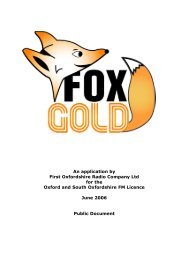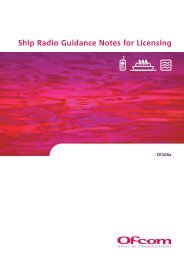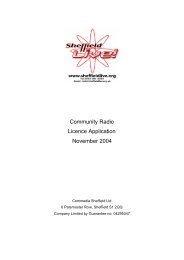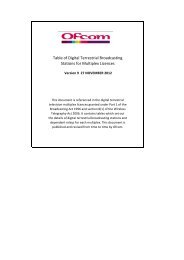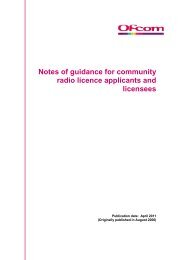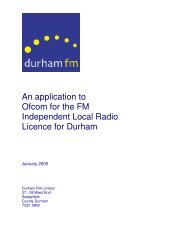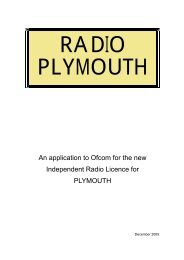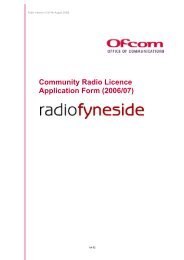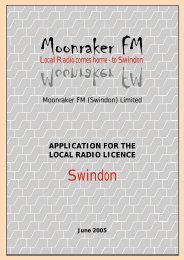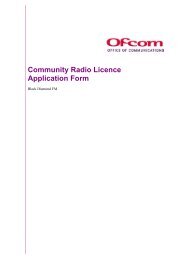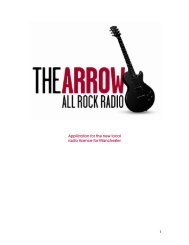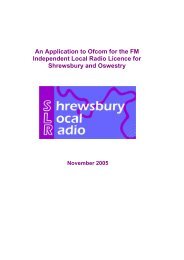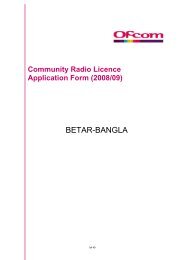You also want an ePaper? Increase the reach of your titles
YUMPU automatically turns print PDFs into web optimized ePapers that Google loves.
Section 105 (D): Evidence of local demand or support<br />
f) A summary of the main findings from the research, showing how these demonstrate evidence of<br />
demand for the service proposed<br />
Radio listening habits<br />
The first series of questions aimed to establish radio listening habits in <strong>Rother</strong>ham. 61% of<br />
respondents described themselves as regular listeners, with the figure highest amongst 15-34<br />
year olds. The other 39% said they sometimes listened to the radio. 27% of respondents<br />
chose Hallam <strong>FM</strong> as the station they listened to most often. This was followed by Galaxy 105<br />
(15%), BBC Radio Sheffield (14%), BBC Radio 2 (11%) and BBC Radio 1 (9%). Hallam <strong>FM</strong><br />
was the most popular choice with all age groups between 25 and 64 – including, perhaps<br />
surprisingly, 55-64 year olds. 15-24 year olds preferred Galaxy 105, with 55% choosing it as<br />
their most listened-to station. BBC Radio Sheffield was the most popular choice among the<br />
65+ age group. However, it’s worth pointing out the strong showing by BBC Radio Sheffield<br />
with all groups over 45. 14% of 45-54 years olds chose it as their most listened-to station, the<br />
same number as those who chose Radio 2. And with the 55-64 year olds, BBC Radio<br />
Sheffield is challenging Hallam <strong>FM</strong> as the most popular choice. These figures show a strong<br />
propensity to listen to local radio, and in particular, commercial local radio such as the<br />
heritage station Hallam <strong>FM</strong>.<br />
Satisfaction levels are currently very high with the current selection of commercial stations<br />
available, with 70% of respondents saying they were “fully satisfied”, and just 3% expressing<br />
any level of dissatisfaction. The challenge for <strong>Rother</strong> <strong>FM</strong> is to offer a new choice that will be<br />
able to make an impact on a marketplace in which potential listeners are already well satisfied<br />
with their listening choice.<br />
Music<br />
As outlined in our account in Question 4. Programming Philosophy we tested five music<br />
groupings by artist name rather than music genre title. These five types of music accounted<br />
in a general way, for the types of music played on the RSL and on the other group stations.<br />
They were Chart Pop (Kylie Minogue, McFly, Girls Aloud); Adult Contemporary (Dido, Robbie<br />
Williams, Joss Stone); Urban (Black-eyed Peas, Mario, Justin Timberlake); Contemporary<br />
Rock (U2, Coldplay, Oasis) and Classic Adult Contemporary (Elton John, the Bee Gees,<br />
Queen).<br />
Classic Adult Contemporary scored most highly for total likelihood to listen, with 62% of all<br />
respondents showing some likelihood. Adult Contemporary, Urban and Modern Rock all<br />
scored just under 50% and Chart Pop was the least popular, with 40%. With the core target<br />
audience of 25-54 year olds, while Classic Adult Contemporary remains the most popular with<br />
63% likelihood to listen, it’s more closely followed by Modern Rock (62%), Adult<br />
Contemporary (57%) and Urban (56%). Chart Pop now climbs to 45%.<br />
Respondents were also given a list of other music genres and eras and asked to tell us which<br />
they’d like to hear more of on the radio. The list was: 60s music, 70s music, 80s music, 90s<br />
music, current pop music, dance, R’n’B, soul, rock, country and jazz. “Current pop music”<br />
39



